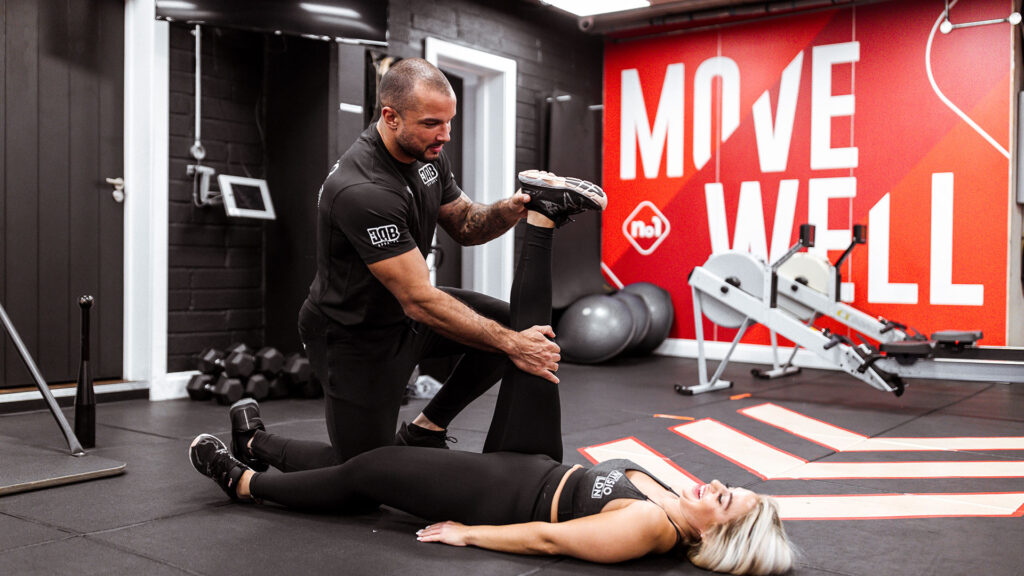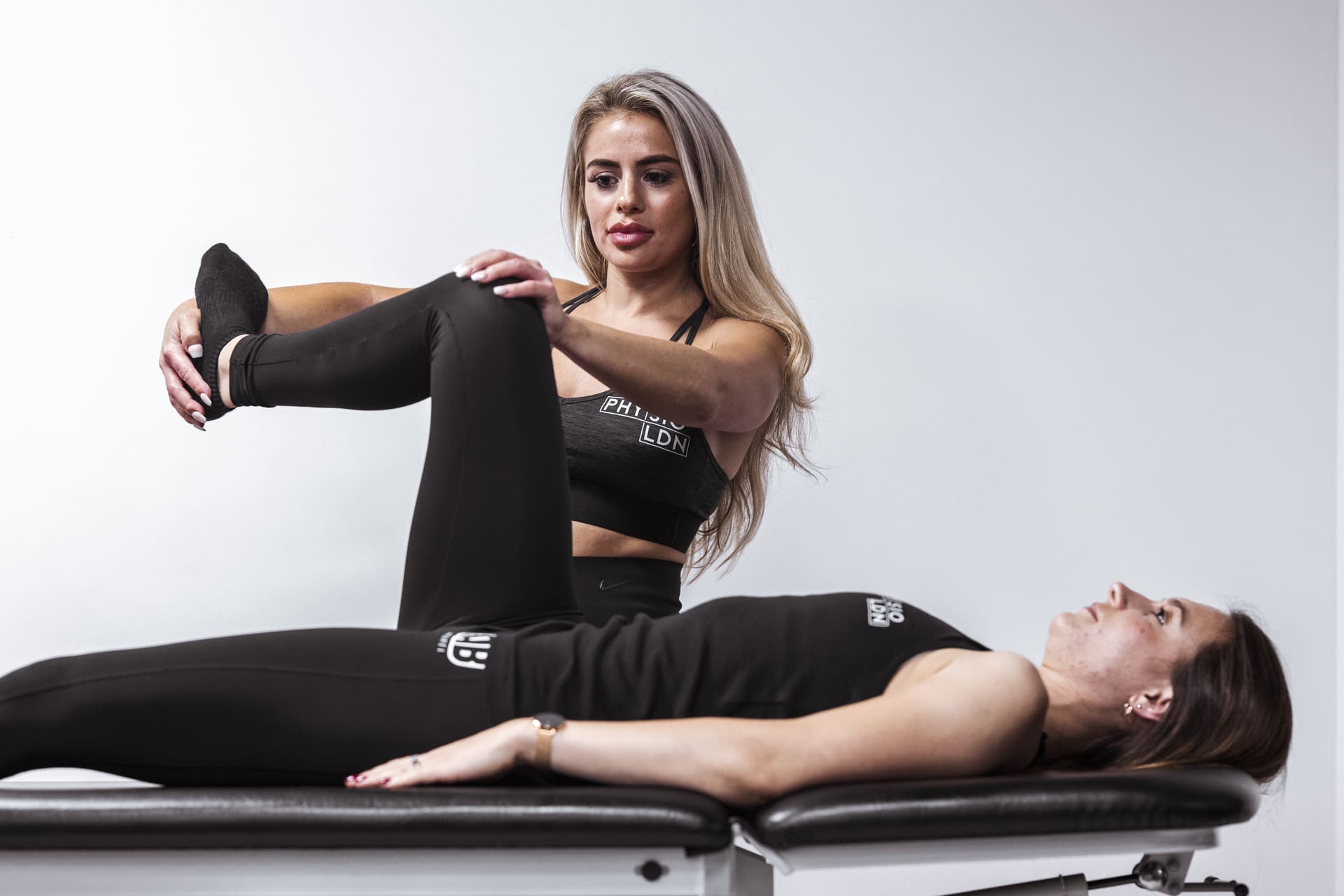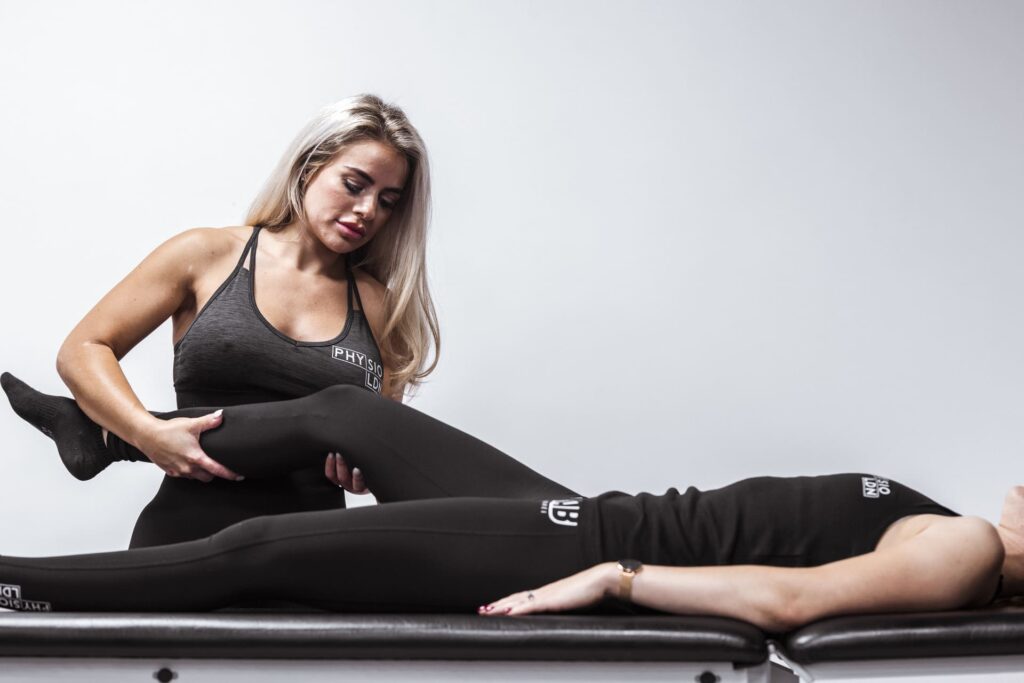Table of Contents
Main Takeaways
- Knee pain when bending often stems from osteoarthritis, injuries, or poor biomechanics.
- Physiotherapy and deep tissue massage relieve pain and restore function.
- Targeted strengthening and stretching exercises improve mobility and stability.
- Braces and lifestyle changes like weight management support long-term relief.
- Early physiotherapy intervention prevents chronic pain and speeds recovery.
Knee pain when bending is a common complaint that affects millions of adults worldwide. With knee pain prevalence having risen by nearly 65% over the past two decades, it now accounts for almost 4 million primary care visits annually, highlighting the growing impact of this condition on daily life and healthcare systems. Understanding why the knee hurts during bending, alongside effective exercises and treatment options like knee pain treatment in London, is essential for managing discomfort and maintaining mobility.
Whether the pain arises from injury, chronic conditions like osteoarthritis, or biomechanical issues, targeted interventions can provide relief and improve function. This article explores the causes of knee pain during bending, recommended exercises and stretches, and the latest treatment approaches to help you regain comfort and confidence in movement.
Why the Knee Hurts When Bending
Knee pain during bending can stem from various underlying causes, ranging from acute injuries to chronic degenerative conditions. The knee joint is complex, involving bones, cartilage, ligaments, tendons, and muscles, all of which must work harmoniously for smooth movement. When any of these structures are compromised, bending the knee can trigger pain.

One of the most common causes is osteoarthritis, a degenerative joint disease characterized by cartilage breakdown and inflammation. Recent research highlights that osteoarthritis pain is highly variable, influenced not only by physical joint changes but also by individual psychosocial and lifestyle factors. This variability underscores the importance of personalized treatment plans to address both physical and emotional aspects of pain.
In addition to osteoarthritis, injuries such as meniscal tears, ligament sprains, or patellar tendonitis can cause pain during knee flexion. Workplace-related knee injuries are also significant, with over 66,000 reported cases in 2020 alone, predominantly in service sectors, reflecting the strain placed on knees during repetitive or strenuous activities. Furthermore, athletes are particularly susceptible to knee injuries; sports that involve sudden stops, jumps, or changes in direction, like basketball and soccer, can lead to acute injuries that may require extensive rehabilitation.
Supportive devices like knee braces can offer immediate relief by redistributing joint load, though patient adherence remains a challenge. Optimizing motor control strategies has also been shown to reduce knee joint forces during activities like walking and squatting, potentially lowering injury risk and pain. In addition to braces, physical therapy modalities such as ultrasound therapy and electrical stimulation can aid in reducing inflammation and promoting healing, making them valuable components of a comprehensive treatment plan.
For those seeking expert assessment and management, London’s leading physiotherapy clinics, such as One Body LDN, offer comprehensive evaluations from specialist London knee pain physiotherapists, to pinpoint the root cause of knee pain and tailor effective interventions. Additionally, these clinics often provide educational resources to empower patients with knowledge about their condition, encouraging active participation in their recovery journey. Understanding the mechanics of knee function and the importance of maintaining a healthy weight can also play a crucial role in managing knee pain and preventing further injury.
Exercises and Stretches
Engaging in appropriate exercises and stretches is a cornerstone of managing knee pain during bending. Strengthening the muscles around the knee, particularly the quadriceps, hamstrings, and calf muscles, helps stabilize the joint and reduce undue stress on affected structures.

Gentle stretching improves flexibility and joint mobility, which can alleviate stiffness and enhance range of motion. For example, hamstring stretches, calf stretches, and quadriceps stretches are commonly recommended to support knee function. Incorporating dynamic stretches before engaging in physical activity can also prepare the knee joint for movement, reducing the risk of injury. Activities such as leg swings and walking lunges not only warm up the muscles but also promote blood flow to the area, ensuring that the knee is ready for action.
Research from 2021 emphasizes the importance of optimizing motor control strategies to lower knee joint forces during functional movements such as walking and squatting. This approach not only reduces pain but also minimizes the risk of further injury, making it a valuable component of rehabilitation programs. Additionally, focusing on balance and proprioception exercises, like single-leg stands or balance board activities, can enhance stability and coordination, further protecting the knee during everyday activities.
Physiotherapists at top London clinics integrate hands-on techniques with personalized exercise plans to ensure safe and effective progression. They also provide guidance on proper movement mechanics and posture to prevent aggravation of symptoms. This individualized attention is crucial, as each person’s experience with knee pain can vary significantly based on their lifestyle, activity levels, and underlying conditions. By tailoring the rehabilitation approach, physiotherapists can help patients achieve optimal outcomes and regain confidence in their movements.
For individuals with osteoarthritis, low-impact activities like swimming or cycling can be beneficial, promoting joint health without excessive loading. Combining these with targeted strengthening and stretching exercises creates a balanced approach to managing knee pain. Furthermore, incorporating mindfulness practices such as yoga or tai chi can enhance overall well-being, as they not only improve physical flexibility but also promote mental relaxation, which can be particularly helpful for those dealing with chronic pain.
For more detailed guidance on exercise therapy and personalized rehabilitation, visiting a specialist physiotherapy clinic in London such as One Body LDN can be invaluable.. Their team of experts can provide a comprehensive assessment and develop a tailored plan that addresses the specific needs of each patient, ensuring that they can engage in their favorite activities with reduced pain and increased functionality.
Treatment Options for Relief
Treatment for knee pain when bending varies depending on the cause and severity but often includes a combination of conservative and advanced interventions. Physiotherapy remains a frontline treatment, focusing on manual therapy, exercise prescription, and education to restore function and reduce pain. Through tailored exercises, physiotherapists can help strengthen the muscles around the knee, which can alleviate pressure on the joint and improve overall stability. This approach not only aids in pain relief but also empowers patients with the knowledge and skills necessary to manage their condition effectively.

Deep tissue sports massage, offered by expert therapists in London, can release muscle tightness, improve circulation, and break down scar tissue, contributing to pain relief and enhanced mobility. Clinics like One Body LDN provide award-winning sports massage services that complement physiotherapy for comprehensive care. The benefits of massage extend beyond immediate relief; regular sessions can enhance flexibility and promote faster recovery from injuries, making it a valuable component of a holistic treatment plan. Furthermore, the therapeutic touch can also have psychological benefits, reducing stress and anxiety associated with chronic pain conditions.
Knee braces and supports can offer immediate mechanical relief by unloading stress from painful joint areas. However, as noted by experts, patient compliance with brace use can be a limiting factor in their effectiveness. It’s crucial for patients to understand how to properly fit and wear these supports to maximize their benefits. Additionally, advancements in brace technology, such as those incorporating adjustable tension systems or lightweight materials, have made them more comfortable and user-friendly, encouraging greater adherence to prescribed use.
Emerging technologies are also shaping knee pain management. A 2024 study introduced an automated system using self-supervised learning to grade knee osteoarthritis severity, potentially enabling more precise and early intervention. Additionally, artificial intelligence is being explored to predict outcomes after knee replacement surgeries, helping tailor postoperative care. The integration of telehealth services is another exciting development, allowing patients to access expert consultations and follow-up care from the comfort of their homes, thus improving accessibility and convenience in managing knee pain.
For chronic conditions like osteoarthritis, treatment plans often include lifestyle modifications, weight management, and pain coping strategies alongside physical therapies. Personalized interventions that consider biopsychosocial factors have been shown to improve patient outcomes significantly. Nutrition plays a pivotal role as well; diets rich in anti-inflammatory foods, such as omega-3 fatty acids and antioxidants, can help mitigate pain and enhance joint health. Moreover, engaging in low-impact activities like swimming or cycling can provide cardiovascular benefits without exacerbating knee discomfort.
Accessing a reputable physiotherapy clinic in London, such as One Body LDN, ensures care from highly trained knee pain professionals who blend evidence-based treatments with ethical, patient-centered practices. Their non-commissioned therapists prioritize your best interests, offering transparent pricing and a no-risk service guarantee. By fostering a collaborative relationship with patients, these clinics can adapt treatment plans based on individual progress and feedback, ensuring a more effective and satisfying recovery journey.
Check out our guide on knee pain relief exercises
FAQ
What causes knee pain specifically when bending?
Knee pain during bending can be caused by osteoarthritis, ligament or meniscus injuries, tendonitis, or biomechanical issues. Degeneration of cartilage or inflammation often leads to discomfort when the joint is flexed. Additionally, conditions such as patellar tendinopathy, often seen in athletes, can exacerbate pain during activities that involve bending. Overuse injuries from repetitive activities, such as running or cycling, can also contribute to the discomfort, as they place excessive strain on the knee joint and surrounding tissues.
Can exercises really help reduce knee pain when bending?
Yes, targeted exercises that strengthen the muscles around the knee and improve flexibility can stabilize the joint, reduce stress, and alleviate pain during bending movements. Incorporating low-impact activities such as swimming or cycling can also be beneficial, as they provide cardiovascular benefits without placing undue stress on the knees. Furthermore, exercises that focus on the hip and core muscles can enhance overall stability and alignment, which is crucial for maintaining proper knee function and minimizing pain during bending.
Are knee braces effective for managing pain during knee bending?
Knee braces can provide immediate relief by supporting the joint and redistributing load. However, their effectiveness depends on proper use and patient compliance. Different types of braces, such as functional braces for stability or unloader braces for pain relief, can be tailored to individual needs. It’s important to consult with a healthcare professional to determine the most suitable type of brace, as improper use can lead to further complications or dependency on the brace.
When should I see a physiotherapist for knee pain?
If knee pain persists, worsens, or limits your daily activities, consulting a physiotherapist is advisable. Early assessment and treatment can prevent chronic issues and improve recovery. A physiotherapist can provide a tailored rehabilitation program that includes manual therapy, modalities like ultrasound or electrical stimulation, and education on proper body mechanics to prevent future injuries. They can also guide you through a gradual return to activities, ensuring that you do not exacerbate the condition.
What treatment options are available besides physiotherapy?
Other treatments include sports massage, use of knee braces, pain management strategies, lifestyle modifications, and in some cases, surgical interventions. Emerging AI technologies also enhance diagnosis and treatment planning. Complementary therapies such as acupuncture and chiropractic care may provide additional relief for some individuals. Moreover, nutritional interventions, including anti-inflammatory diets, can support joint health and potentially reduce pain associated with knee conditions.
Is private physiotherapy better than NHS for knee pain?
Private physiotherapy often offers shorter waiting times, longer sessions, and personalized care, which can lead to faster and more effective recovery compared to NHS services with longer waitlists and shorter appointments. In private settings, physiotherapists may have access to advanced treatment modalities and technologies that can enhance rehabilitation outcomes. However, it is essential to weigh the benefits against the costs, as private treatment can be significantly more expensive than NHS options.
How common is knee pain in adults?
Approximately 25% of adults experience knee pain, with prevalence increasing by nearly 65% over the last 20 years, leading to millions of healthcare visits annually. This rise can be attributed to various factors, including an aging population, increased participation in sports, and higher rates of obesity, which places additional strain on the knee joints. As a result, knee pain has become a significant public health concern, prompting research into prevention and management strategies.
Can lifestyle factors affect knee osteoarthritis pain?
Yes, psychosocial and lifestyle factors significantly influence the experience of osteoarthritis pain, making personalized treatment approaches essential for effective management. Factors such as stress, anxiety, and depression can exacerbate pain perception, while maintaining a healthy weight and engaging in regular physical activity can mitigate symptoms. Additionally, social support and community engagement have been shown to improve outcomes for individuals with osteoarthritis, highlighting the importance of a holistic approach to treatment that addresses both physical and emotional well-being.
Take Control of Your Knee Pain with One Body LDN
Don’t let knee pain hold you back from living your best life. At One Body LDN, voted as the best London physio clinic by thousands, we understand the complexities of knee pain and are dedicated to helping you overcome it. Our expert team, including former athletes and NHS specialists, will work with you to fix the root cause of your problem through personalized assessments and rehabilitation plans. Specializing in musculoskeletal physiotherapy and sports injuries, we’re equipped to handle everything from gym injuries to post-operative care. Experience our award-winning combination of exercise rehab and deep tissue massage, and feel confident in our results-based approach. Book your free initial assessment at our clinic today and take the first step towards lasting relief and optimal physical health.


